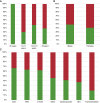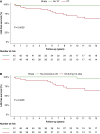Prognostic relevance of baseline exercise stress test in RYR2-related CPVT
- PMID: 39907480
- PMCID: PMC11795671
- DOI: 10.1093/europace/euae294
Prognostic relevance of baseline exercise stress test in RYR2-related CPVT
Abstract
Aims: Exercise stress test (EST) represents the gold standard for diagnosis of catecholaminergic polymorphic ventricular tachycardia (CPVT). We aimed to determine the relevance of exercise induced VT for the occurrence of LAE at follow-up.
Methods and results: In RYR2-related CPVT patients who underwent a baseline EST, we assessed the incidence and severity of ventricular arrhythmias (VA). Data were analysed using logistic regression models and Cox proportional hazards models. The primary outcome was the occurrence of life-threatening arrhythmic event (LAE; composite of sudden cardiac death, aborted cardiac arrest, or hemodynamically non-tolerated VT) at follow-up. In 102 RYR2-related CPVT patients (65 females; median age 16 years, IQR: 11-36 years), exercise-induced VT (bidirectional in 64% of cases) was elicited in 56% patients. VT could not be induced in pre-school children. Lower basal heart rate, early onset VA (within the first step of EST) and heart rate at the first minute of recovery were associated with exercise-induced VT. Cox analyses showed that early onset VA (HR 6.0, 95% CI: 1.3-27.9, P = 0.022) and exercise-induced VT (HR 6.6, 95% CI: 1.5-29.1, P = 0.012) at baseline EST were significantly associated with the occurrence of LAE at follow-up, and remained associated even after correction for symptoms.
Conclusion: Early onset VA and exercise-induced VT at baseline EST was associated with LAE at follow-up, allowing to identify a sub-set of patients at higher risk already at diagnosis.
Keywords: CPVT; Exercise stress test; Life-threatening arrhythmic event; Sudden cardiac death; Ventricular tachycardia.
© The Author(s) 2025. Published by Oxford University Press on behalf of the European Society of Cardiology.
Conflict of interest statement
Conflict of interest: none declared.
Figures





References
-
- Priori SG, Mazzanti A, Santiago DJ, Kukavica D, Trancuccio A, Kovacic JC. Precision medicine in catecholaminergic polymorphic ventricular tachycardia: JACC focus seminar 5/5. J Am Coll Cardiol 2021;77:2592–612. - PubMed
-
- Priori SG, Wilde AA, Horie M, Cho Y, Behr ER, Berul C et al. HRS/EHRA/APHRS expert consensus statement on the diagnosis and management of patients with inherited primary arrhythmia syndromes: document endorsed by HRS, EHRA, and APHRS in May 2013 and by ACCF, AHA, PACES, and AEPC in June 2013. Hear Rhythm 2013;10:1932–63. - PubMed
-
- Zeppenfeld K, Tfelt-Hansen J, de Riva M, Winkel BG, Behr ER, Blom NA et al. 2022 ESC guidelines for the management of patients with ventricular arrhythmias and the prevention of sudden cardiac death. Eur Heart J 2022;43:3997–4126. - PubMed
-
- Coumel P, Fidelle J, Lucet V, Attuel P, Bouvrain Y. Catecholamine-induced severe ventricular arrhythmias with Adams-Stokes syndrome in children: report of four cases. Br Heart J 1978;40:28–37.
-
- Priori SG, Napolitano C, Tiso N, Memmi M, Vignati G, Bloise R et al. Mutations in the cardiac ryanodine receptor gene (hRyR2) underlie catecholaminergic polymorphic ventricular tachycardia. Circulation 2001;103:196–200. - PubMed
MeSH terms
Substances
Grants and funding
LinkOut - more resources
Full Text Sources
Research Materials

